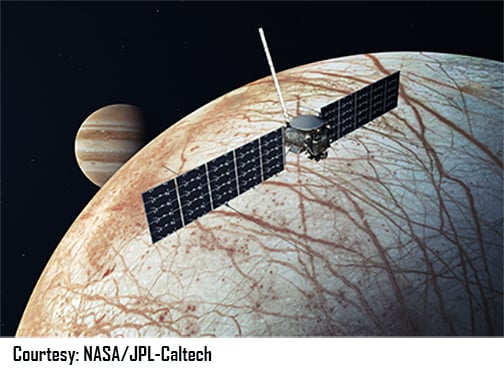
NASA's Europa Clipper was launched in October 2024 and is expected to reach Jupiter’s ice-covered moon Europa in 2030. Europa is the sixth-largest moon in the Solar System and contains a salty global ocean with more liquid water than all of Earth’s oceans combined.
The Europa Clipper will conduct a detailed exploration of the moon and explore whether it has an environment suitable for life.
Collaborating with the Arizona State University School of Earth and Space Exploration, Materion’s Westford Optics team developed processes in photolithography and metallization to generate a solderable seal ring on customer-furnished diamond substrates. These CVD diamond windows contained extremely precise microstructures etched into the surface of the substrate that will be used for their spectral properties instead of a more traditional thin film optical coating. Once the team overcame the challenges associated with these unique windows and they were successfully metallized, the team developed a solder reflow process to hermetically seal the metallized window into a machined Invar bezel. This Visi-Lid assembly will enable the Europa Thermal Emission Imaging System (E¬THEMIS) to provide high spatial resolution, multi-spectral imaging of the moon in the mid-wave infrared and long-wave infrared bands to help characterize plumes erupting water into space.
“I am proud of the technical capabilities the team demonstrated which allowed us to be part of this exciting mission in exploring and imaging Europa. We are excited to continue expanding our heritage in Space Applications and are well positioned to support any future missions,” Mike Reedy, VP and General Manager for Materion Precision Optics (Westford) said.
Materion Corporation has a long history of contributing to various global space programs dating as far back as the 1960s, supporting major U.S. and international space and astronomy missions. It’s exciting to look back at how the spirit of innovation driving us today has played such a crucial role over the years in the advancement of various space technologies and programs. Materion’s proud legacy can be traced back from Project Mercury, the Hubble Space Telescope, Landsat, and to more recent innovations such as the Mars Rover Perseverance, Legacy Survey of Space and Time (LSST), and the James Webb Telescope.
To learn more about all the Materion products used throughout the aerospace industry, please visit our aerospace market page on Materion.com.